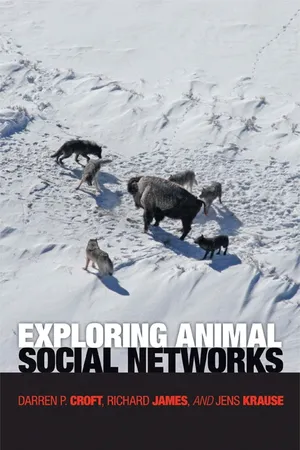
- 208 pages
- English
- PDF
- Available on iOS & Android
Exploring Animal Social Networks
About this book
Social network analysis is used widely in the social sciences to study interactions among people, groups, and organizations, yet until now there has been no book that shows behavioral biologists how to apply it to their work on animal populations. Exploring Animal Social Networks provides a practical guide for researchers, undergraduates, and graduate students in ecology, evolutionary biology, animal behavior, and zoology.
Existing methods for studying animal social structure focus either on one animal and its interactions or on the average properties of a whole population. This book enables researchers to probe animal social structure at all levels, from the individual to the population. No prior knowledge of network theory is assumed. The authors give a step-by-step introduction to the different procedures and offer ideas for designing studies, collecting data, and interpreting results. They examine some of today's most sophisticated statistical tools for social network analysis and show how they can be used to study social interactions in animals, including cetaceans, ungulates, primates, insects, and fish. Drawing from an array of techniques, the authors explore how network structures influence individual behavior and how this in turn influences, and is influenced by, behavior at the population level. Throughout, the authors use two software packages--UCINET and NETDRAW--to illustrate how these powerful analytical tools can be applied to different animal social organizations.
Frequently asked questions
- Essential is ideal for learners and professionals who enjoy exploring a wide range of subjects. Access the Essential Library with 800,000+ trusted titles and best-sellers across business, personal growth, and the humanities. Includes unlimited reading time and Standard Read Aloud voice.
- Complete: Perfect for advanced learners and researchers needing full, unrestricted access. Unlock 1.4M+ books across hundreds of subjects, including academic and specialized titles. The Complete Plan also includes advanced features like Premium Read Aloud and Research Assistant.
Please note we cannot support devices running on iOS 13 and Android 7 or earlier. Learn more about using the app.
Information
Table of contents
- Cover
- Contents
- Preface
- 1. Introduction to Social Networks
- 2. Data Collection
- 3. Visual Exploration
- 4. Node-Based Measures
- 5. Statistical Tests of Node-Based Measures
- 6. Searching for Substructures
- 7. Comparing Networks
- 8. Conclusions
- Glossary of Frequently Used Terms
- References
- Index